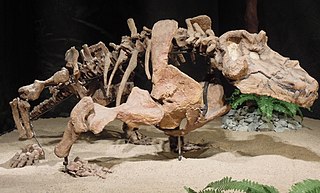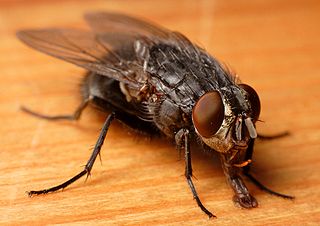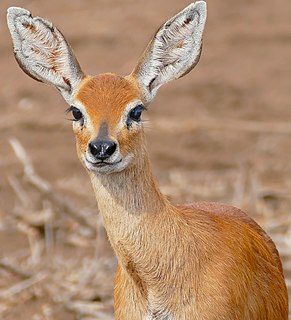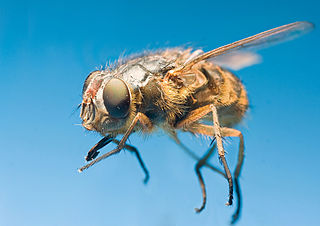
The Ural owl is a large nocturnal owl. It is a member of the true owl family, Strigidae. The Ural owl is a member of the genus Strix, that is also the origin of the family’s name under Linnaean taxonomy. Both its common name and scientific name refer to the Ural Mountains of Russia where the type specimen was collected. However, this species has an extremely broad distribution that extends as far west as much of Scandinavia, montane eastern Europe, and, sporadically, central Europe, thence sweeping across the Palearctic broadly through Russia to as far east as Sakhalin and throughout Japan. The Ural owl may include up to 15 subspecies, but most likely the number may be slightly fewer if accounting for clinal variations.

Apodemus is a genus of Muridae. The name is unrelated to that of the Mus genus, instead being derived from the Greek ἀπό-δημος.

Estemmenosuchus is an extinct genus of large, early omnivorous therapsid. It is believed and interpreted to have lived during the middle part of the Middle Permian around 267 million years ago. The two species, E. uralensis and E. mirabilis, are characterised by distinctive horn-like structures, which were probably used for intra-specific display. Both species of Estemmenosuchus are from the Perm region of Russia. Two other estemmenosuchids, Anoplosuchus and Zopherosuchus, are now considered females of the species E. uralensis. There were many complete and incomplete skeletons found together.

Calliphora is a genus of blow flies, also known as bottle flies, found in most parts of the world, with the highest diversity in Australia. The most widespread species in North America area Calliphora livida, C. vicina, and C. vomitoria.

Raphicerus is a genus of small antelopes of the tribe Neotragini.

Calliphora vomitoria, known as the blue bottle fly, orange-bearded blue bottle, or bottlebee is a species of blow fly, a species in the family Calliphoridae. Calliphora vomitoria is the type species of the genus Calliphora. It is common throughout many continents including Europe, Americas, and Africa. They are fairly large flies, nearly twice the size of the housefly. They can be easily identified by their shiny, blue bodies.
The Catalogue of Life is an online database that provides the most comprehensive and authoritative index of known species of animals, plants, fungi, and microorganisms. It was created in 2001 as a partnership between the global Species 2000 and the American Integrated Taxonomic Information System. The Catalogue interface is available in twelve languages and is used by research scientists, citizen scientists, educators, and policy makers. The Catalogue is also used by the Biodiversity Heritage Library, the Barcode of Life Data System, Encyclopedia of Life, and the Global Biodiversity Information Facility. The Catalogue currently compiles data from 168 peer-reviewed taxonomic databases, that are maintained by specialist institutions around the world. As of June 2021, the Catalogue lists 1,997,284 of the world's 2.2m extant species known to taxonomists on the planet at present time.

The Ural field mouse is a species of rodent in the family Muridae. It is also known as the pygmy field mouse. It is found in Armenia, Austria, Azerbaijan, Belarus, Bulgaria, China, Croatia, Czech Republic, Estonia, Georgia, Hungary, Kazakhstan, Latvia, Liechtenstein, Lithuania, Mongolia, Montenegro, Poland, Romania, Russian Federation, Serbia, Slovakia, Turkey and Ukraine.

The long-tailed mole is a species of mole in the family Talpidae. It is found in China, Vietnam and Myanmar.
Erich Martin Hering was a German entomologist who specialised in leafmining insects, He was a curator in the Museum für Naturkunde in Berlin, where his collections of Lepidoptera, Coleoptera, Hymenoptera, Diptera are conserved. His collections of Agromyzidae are shared between MfN and the Agricultural School at Portici now part of the University of Naples Federico II.

Calliphora vicina is a member of the family Calliphoridae, which includes blow flies and bottle flies. These flies are important in the field of forensic entomology, being used to estimate the time of a person's death when a corpse is found and then examined. C. vicina is currently one of the most entomologically important fly species for this purpose because it arrives at and colonizes a body following death in consistent timeframes.

Calliphora livida is a member of the family Calliphoridae, the blow flies. This large family includes the genus Calliphora, the "blue bottle flies". This genus is important in the field of forensic entomology because of its value in post-mortem interval estimation.
Calliphora loewi is part of the family Calliphoridae, bottle flies and blowflies, and in the genus Calliphora, blue bottle flies. The genus can be deceiving since C. loewi is not blue. Though this species is rare, it can play an important part in forensic entomology, spreading disease, and decomposing carrion. The life cycle of C. loewi is similar to the life cycle of the genus Calliphora. Since this species is rare there has not been very much research done with this species.
Hyocephalidae are a small family of Heteroptera which are endemic to Australia.

Calliphora hilli is a blow fly species in the genus Calliphora.
Kazakhstan blind mole-rat is an extant species of blind mole-rat indigenous to Kazakhstan, along the Ural River basin and the flood plains of the Uil, Temir, and Emba rivers. Whereas the species inhabits an area approximately 100,000 km2 in size, the International Union for Conservation of Nature (IUCN) describes S. uralensis as rare and its habitat prone to overgrazing. In 1993, Puzachenko's morphometric analysis demonstrated that the species was distinct from S. giganteus.

Calliphora stygia, commonly known as the brown blowfly, or rango tumaro in Māori, is a species of blow-fly that is found in Australia and New Zealand. The brown blowfly has a grey thorax and yellow-brown abdomen.
Alfred Frank Millidge was a British arachnologist who wrote several works on spiders. One of his best-known might be British Spiders, volumes I and II, which he co-wrote with G. H. Locket. In 1983, he became the first person to describe the spider species Walckenaeria crocea.

Calliphora quadrimaculata, commonly known as the New Zealand blue blowfly and by its Māori name rango pango, is an insect in the genus Calliphora of family Calliphoridae in the order Diptera. This particular blowfly is found throughout New Zealand as well as on Chatham, Auckland, Stewart and Campbell Islands that surround New Zealand. Generally blowfly maggots in New Zealand have to feed on animal tissue or faeces to develop into adult blowflies. However the New Zealand blue blowfly larvae can survive on decaying leaves of snow tussock in alpine regions and reach adult maturity without feeding on any animal tissue.
Calliphora coloradensis is a species of blow fly in the family Calliphoridae.












